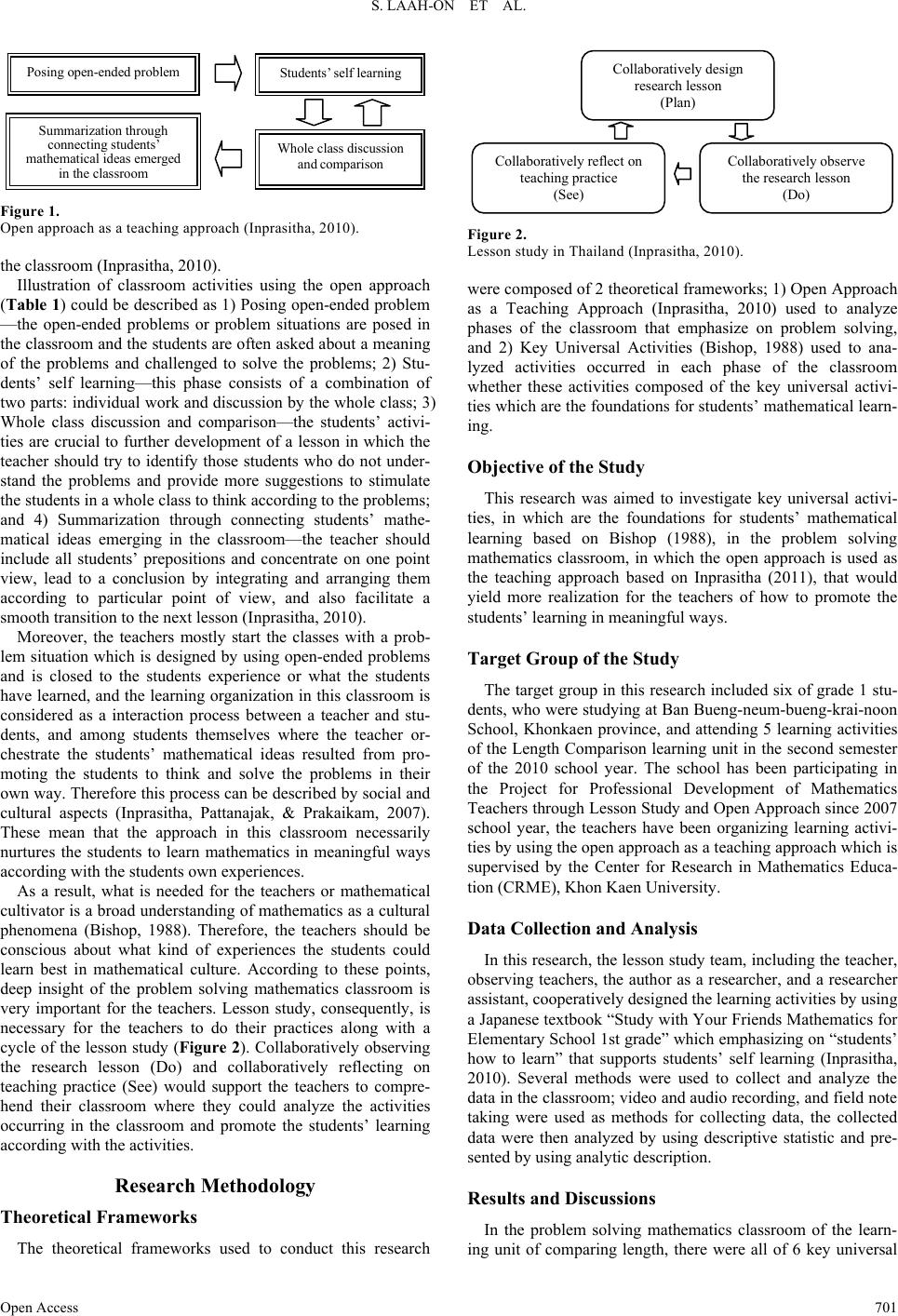
S. LAAH-ON ET AL.
Summariza tion through
connec ti ng st udents’
mathematical ideas emerged
in the classr oom
Whole c lass discussion
and comparison
Students’ self learning
Posing open-ended problem
Figure 1.
Open approach as a teaching approach (Inprasitha, 2010).
the classroom (Inprasitha, 2010).
Illustration of classroom activities using the open approach
(Table 1) could be described as 1) Posing open-ended problem
—the open-ended problems or problem situations are posed in
the classroom and the students are often asked about a meaning
of the problems and challenged to solve the problems; 2) Stu-
dents’ self learning—this phase consists of a combination of
two parts: individual work and discussion by the whole class; 3)
Whole class discussion and comparison—the students’ activi-
ties are crucial to further development of a lesson in which the
teacher should try to identify those students who do not under-
stand the problems and provide more suggestions to stimulate
the students in a whole class to think according to the problems;
and 4) Summarization through connecting students’ mathe-
matical ideas emerging in the classroom—the teacher should
include all students’ prepositions and concentrate on one point
view, lead to a conclusion by integrating and arranging them
according to particular point of view, and also facilitate a
smooth transition to the next lesson (Inprasitha, 2010).
Moreover, the teachers mostly start the classes with a prob-
lem situation which is designed by using open-ended problems
and is closed to the students experience or what the students
have learned, and the learning organization in this classroom is
considered as a interaction process between a teacher and stu-
dents, and among students themselves where the teacher or-
chestrate the students’ mathematical ideas resulted from pro-
moting the students to think and solve the problems in their
own way. Therefore this process can be described by social and
cultural aspects (Inprasitha, Pattanajak, & Prakaikam, 2007).
These mean that the approach in this classroom necessarily
nurtures the students to learn mathematics in meaningful ways
according with the students own experiences.
As a result, what is needed for the teachers or mathematical
cultivator is a broad understanding of mathematics as a cultural
phenomena (Bishop, 1988). Therefore, the teachers should be
conscious about what kind of experiences the students could
learn best in mathematical culture. According to these points,
deep insight of the problem solving mathematics classroom is
very important for the teachers. Lesson study, consequently, is
necessary for the teachers to do their practices along with a
cycle of the lesson study (Figure 2). Collaboratively observing
the research lesson (Do) and collaboratively reflecting on
teaching practice (See) would support the teachers to compre-
hend their classroom where they could analyze the activities
occurring in the classroom and promote the students’ learning
according with the activities.
Research Methodology
Theoretical Frameworks
The theoretical frameworks used to conduct this research
Collaboratively de sign
research l esson
Plan
Collaboratively observe
the research lesson
(Do)
Collaborati vely reflect on
teaching p ractice
(See)
Figure 2.
Lesson study in Thailand (Inprasitha, 2010).
were composed of 2 theoretical frameworks; 1) Open Approach
as a Teaching Approach (Inprasitha, 2010) used to analyze
phases of the classroom that emphasize on problem solving,
and 2) Key Universal Activities (Bishop, 1988) used to ana-
lyzed activities occurred in each phase of the classroom
whether these activities composed of the key universal activi-
ties which are the foundations for students’ mathematical learn-
ing.
Objective of the Study
This research was aimed to investigate key universal activi-
ties, in which are the foundations for students’ mathematical
learning based on Bishop (1988), in the problem solving
mathematics classroom, in which the open approach is used as
the teaching approach based on Inprasitha (2011), that would
yield more realization for the teachers of how to promote the
students’ learning in meaningful ways.
Target Group of the Study
The target group in this research included six of grade 1 stu-
dents, who were studying at Ban Bueng-neum-bueng-krai-noon
School, Khonkaen province, and attending 5 learning activities
of the Length Comparison learning unit in the second semester
of the 2010 school year. The school has been participating in
the Project for Professional Development of Mathematics
Teachers through Lesson Study and Open Approach since 2007
school year, the teachers have been organizing learning activi-
ties by using the open approach as a teaching approach which is
supervised by the Center for Research in Mathematics Educa-
tion (CRME), Khon Kaen University.
Data Collection and Analysis
In this research, the lesson study team, including the teacher,
observing teachers, the author as a researcher, and a researcher
assistant, cooperatively designed the learning activities by using
a Japanese textbook “Study with Your Friends Mathematics for
Elementary School 1st grade” which emphasizing on “students’
how to learn” that supports students’ self learning (Inprasitha,
2010). Several methods were used to collect and analyze the
data in the classroom; video and audio recording, and field note
taking were used as methods for collecting data, the collected
data were then analyzed by using descriptive statistic and pre-
sented by using analytic description.
Results and Discussions
In the problem solving mathematics classroom of the learn-
ing unit of comparing length, there were all of 6 key universal
Open Access 701